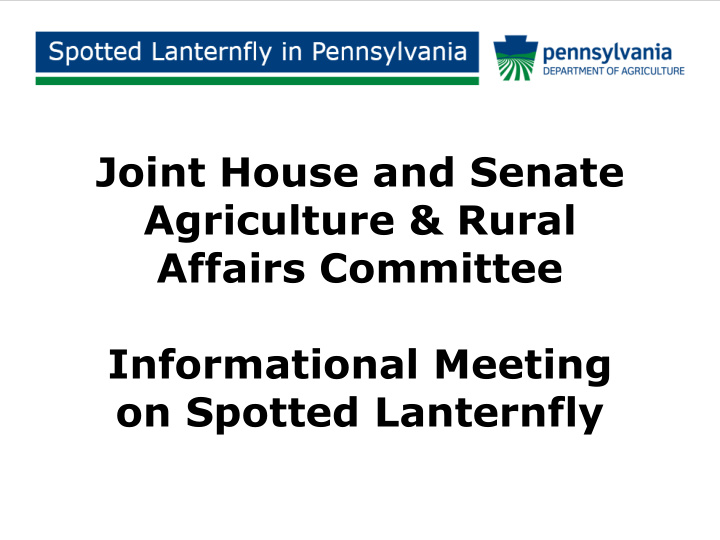



Joint House and Senate Agriculture & Rural Affairs Committee Informational Meeting on Spotted Lanternfly
On September 22, 2014, the Entomology Program of the Pennsylvania Department of Agriculture received a report from an educator from the Pennsylvania Game Commission The report detailed damage to Ailanthus altissima (Tree of Heaven) on private property in Eastern Berks County, PA being caused by an unknown insect
Lycorma delicatula (WHITE): • A Planthopper in the Family Fulgoridae • 696 Species of Lanternflies in the world Christopher Marley Planthopper Formation • Only 17 species in North America • Like most planthoppers, Lycorma pierce the stems of plants, trees, and vines and feed on phloem.
The spotted lanternfly is native to Asia and is found in China, Bangladesh, Vietnam It was introduced to Japan, South Korea and Pennsylvania In South Korea, it is considered an invasive pest and impacts grapes and peaches
Current Distribution
Spotted Lanternfly makes use of over 70 different plant species, but strongly prefers the invasive “Tree of Heaven” Tree of Heaven Distribution-USDA PLANTS Database
Impact: Damage grape, hops, orchards, hardwood, and nursery industries Damage comes from feeding waste (honeydew) Which turns into sooty mold
Impact: Damage reported on basil, blueberry, cucumber and horseradish in 2017
Impact: Presence on other crops, alfalfa, soy, corn with reports of reduced yield on alfalfa. No feeding documented.
Impact: Heavy Feeding on Walnut, Red Oak, Maple, and Hickory resulted in flagging and dieback
Impact: Flagged branches had several spotted lanternflie s feeding
Impact: Adult clustering, swarming and Honeydew accumulation can impact quality of life .
Egg Laying: Adults: July - December September - Eggs: October - June November One Generation Per Year Fourth Instar: Hatch and 1st July - September Instar: May - June Third Instar: June - July Second Instar: June - July
Egg masses contain between 30-50 eggs, are laid on many different objects, and are often well hidden
Egg masses that can be seen or reached are easily controlled by scraping
Immature stages migrate up trees/plants each day and are easily caught on sticky tree bands
Adults begin to appear in late summer, feed preferentially on Ailanthus, mate, and lay eggs Males and females mate multiple times
All life stages can hitchhike to new areas, but eggs and adults pose the greatest risk for movement
Swarming adults present a biosecurity challenge, and can impact trade
The Spotted lanternfly program relies on cooperation. Local officials, state agencies, lead the organizational charge. Extension, Universities, and the USDA research new methods to deal with this pest. PDA crews, USDA crews, volunteers, property owners, local municipalities and businesses work in concert
Spotted Lanternfly Numbers through 2017 10,589 Trees Banded, Killing 1,010,751 Lycorma Egg mass scraping killed 1,667,960 Lycorma 18,000 Public reports investigated, 98% accurate Ailanthus removal/trap tree setup underway
Removal-Trap Tree Method Most Ailanthus are removed or killed with herbicide
Host Reduction Remove Most Ailanthus Leave a few male trees and treat with systemic insecticide
Trap trees July-September 4th Instar and Adults SLFs concentrate to feed on Tree of Heaven with insecticide and die
Removal-Trap Tree Method The trap trees attract and the insecticide kills
Impact on Adults is Dramatic
Impact on Adults is Dramatic
Impact on Adults is Dramatic
1,462 properties known to be infested Public reports aid new detections, many are single specimens Spread seems linked to hitchhiking specimens
As the population of spotted lanternfly grows, and the insect adapts, new threats to multiple industries emerge It is clear that more help is needed to contain this pest
THANK YOU agriculture.pa.gov/SpottedLanternflyAlert
Recommend
More recommend